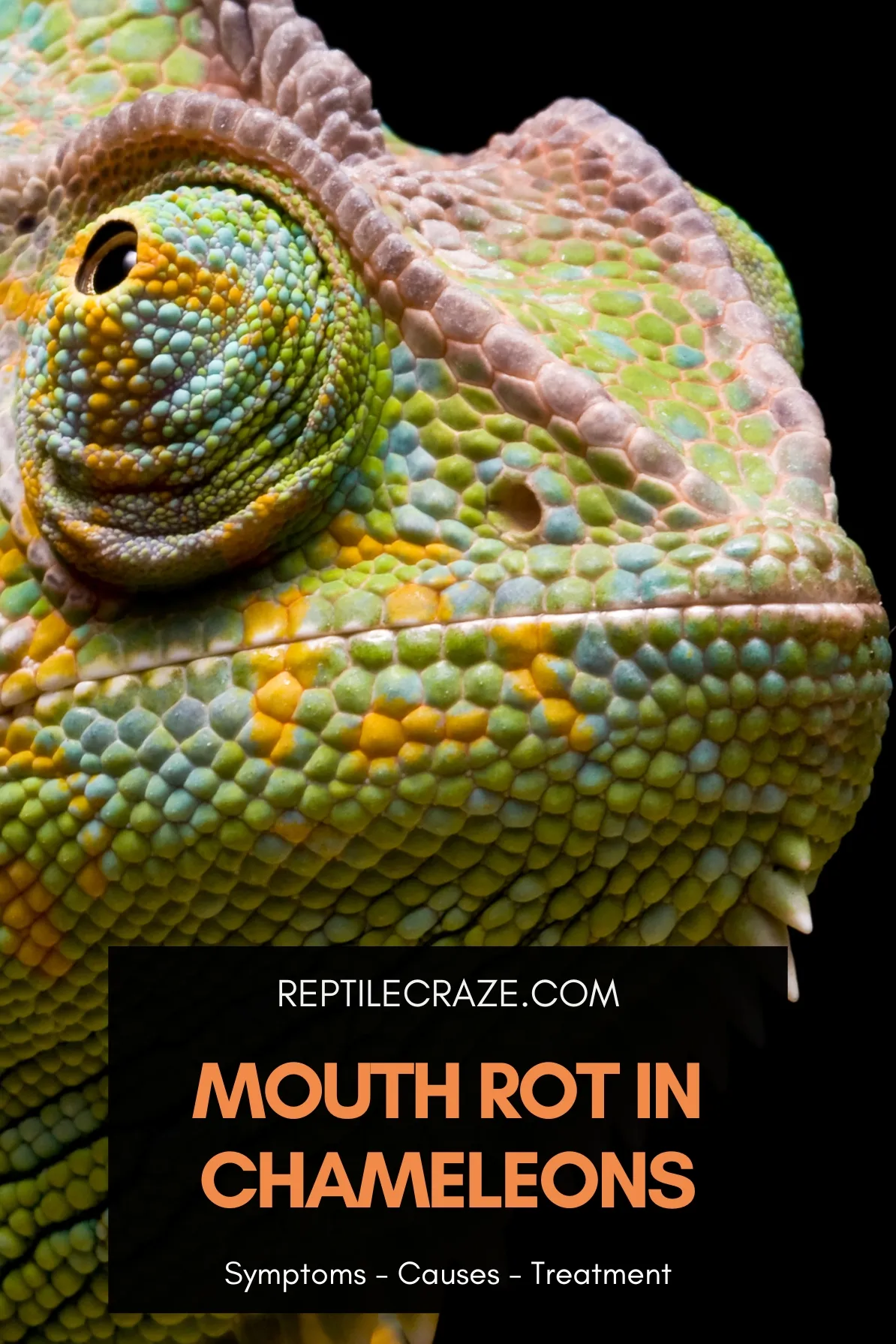
It can be pretty worrying when you notice your reptile pet has some signs of disease. By checking on pets regularly, and getting to know their habits, routines, and preferences, we increase the chances of spotting problems early.
Mouth rot can occur after an injury in a chameleon’s mouth is colonized by harmful bacteria. It’s often influenced by poor husbandry. Symptoms are swollen gums, decreased appetite, and pus in the mouth. It requires veterinary treatment such as cleaning, antibiotics, or surgery.
In this article, we’ll explain all you need to know about mouth rot in chameleons such as:
- Causes
- Progression
- Symptoms
- Treatment
- Prevention.
Table of Contents
What Is Mouth Rot In Chameleons?
Mouth rot, also known as ‘stomatitis‘ (inflammation of the mouth) is a painful infection of the gums, tongue, and palate occurring in some reptile species.
It’s pretty common in chameleons but there are some things pet parents can do to help prevent it (we’ll talk about that later).
Untreated mouth rot, apart from being extremely painful, can also develop into a more serious disease called ‘osteomyelitis’. In this case, the bone, and or muscle surrounding the mouth also becomes infected.
Chameleon Mouth Rot Causes
There are a few factors that can contribute to the development of mouth rot in chameleons. In general, any factor which has a negative impact on a chameleon’s health is a risk factor for a disease.
We’ll discuss these risks in this section, but first, let’s take a look at how mouth rot can develop in chameleons.
The first step in the development of mouth rot is some kind of traumatic injury to the mouth.
Physiologically, the mouth contains bacteria, however, if a chameleon is stressed or immunosuppressed for some reason, these populations of bacteria can be imbalanced and harmful species can thrive.
Following damage to the mouth structures, these harmful bacteria have the perfect entry point into the body and a nice place to start a home.
This means that their numbers increase and your chameleon starts to feel unwell.
Examples of the species of bacteria that can cause mouth rot include:
- Aeromonas (the most common one)
- Pseudomonas
- Salmonella
- Klebsiella
- Mycobacterium.
Once these bacteria enter damaged tissue in the mouth, they have a perfect place to live and hence the chameleon starts to feel unwell.
Let’s now take a look at some of the factors which can contribute to lowered immunity and hence to your chameleon becoming sick.
Mouth Injury
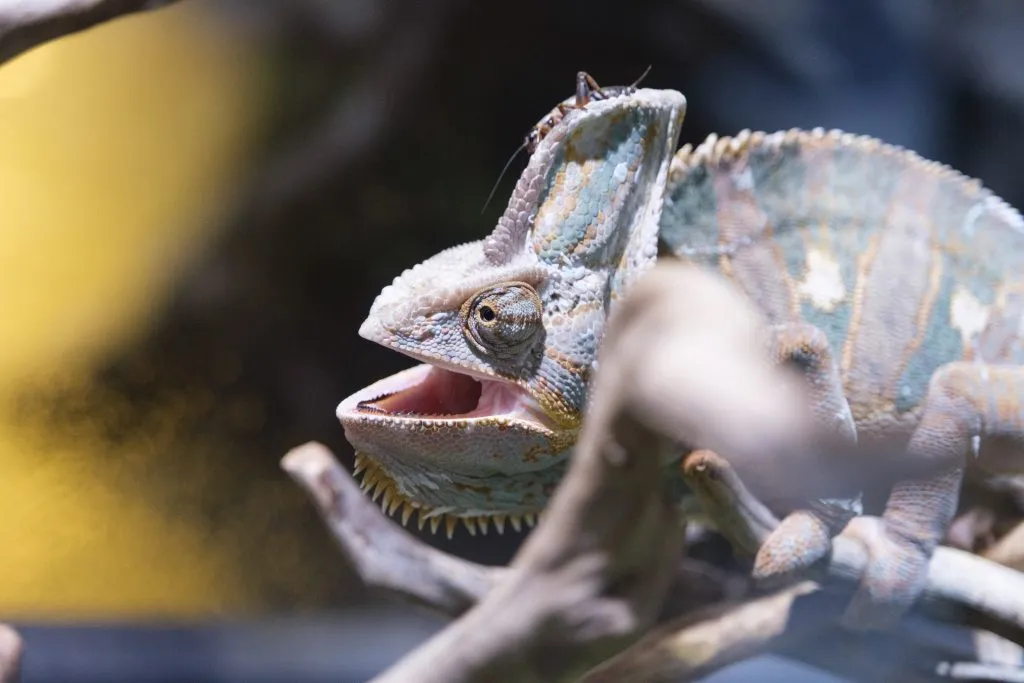
As we already mentioned, usually mouth rot occurs after an injury in the mouth or surrounding structures provides an entry route for bacteria.
Injuries can be any type of scratch, graze, or puncture, of this area and can be a result of:
- A chameleon being bitten by a live feeder insect
- A chameleon hurting their mouth whilst eating (insects can have sharp parts or spines)
- Bites from other chameleons
- Hurting themselves on objects in their
tank .
Incorrect Tank Environment
Inappropriate temperature and humidity in a chameleon’s
- deviations from the optimum environmental parameters can cause stress which can decrease the functioning of a chameleon’s immune system
- temperature or humidity changes can favor the growth of harmful bacteria.
Improper Diet
A chameleon who isn’t fed the correct
Chameleons who don’t have a proper diet, may also suffer from deficiency diseases, which also increase their susceptibility to mouth rot.
In general, any chameleon who isn’t eating or drinking enough (for whatever reason), is weaker and more susceptible to diseases compared to a chameleon who’s eating and drinking normally.
Stress

Anything which causes a chameleon stress can increase their susceptibility to disease. Examples of situations that can cause a chameleon to feel stressed include (source):
- Housing more than one chameleon together
- Handling
- Unclean environment (when the
tank is not cleaned regularly enough) - Inappropriate environmental conditions.
Chameleon Mouth Rot Symptoms
In this section, we’ll go through the progression of symptoms that can be seen when a chameleon has mouth rot.
1. Swollen Gums
Gums can increase in size and may also become red. Swollen gums are painful and can lead to a chameleon eating less.
This is usually the first symptom which very observant pet parents may see in a chameleon with mouth rot.
As we mentioned earlier, mouth rot develops when bacteria enter a wound in a chameleon’s mouth. Swelling can be seen both as a result of the initial injury and as the body’s response to bacteria entering the wound.
2. Decreased Appetite And Activity
Mouth rot can lead to decreased appetite because of the reaction of a chameleon’s immune system to disease.
It’s difficult to differentiate this from a chameleon who’s eating less because of the physical pain caused by the infection.
The body’s attempt to fight off disease-causing microorganisms often decreases appetite as a result of the inflammatory mediators produced by the immune system.
If you take your chameleon to a veterinarian, they will most likely recommend a different way of feeding, which is less painful (for example using a syringe).
It’s important that a chameleon keeps eating, no matter how ill they are. This is because they need energy for healing.
A chameleon who’s suffering from mouth rot may also be less active, for the same reason as we described above. This means they may spend less time climbing, and even may hide in their
3. Pus In Or Around The Mouth
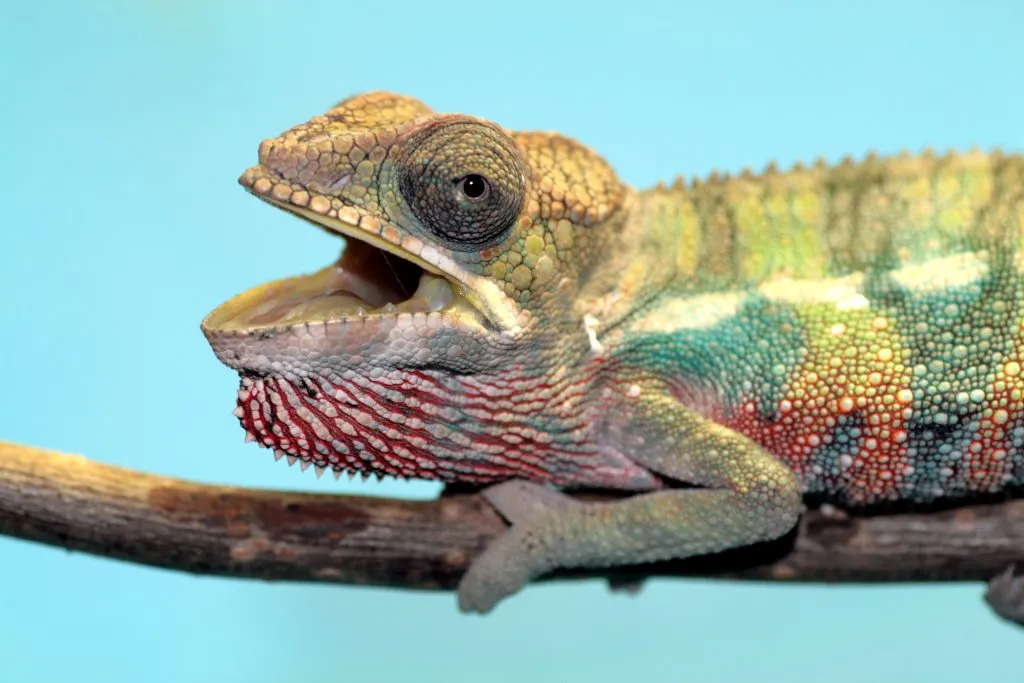
As mouth rot progresses, you may be able to see pus in or around the mouth. This can be yellow or green in color and may even have a foul smell.
Pus is a sign of infection and contains immune cells, bacteria, and dead tissue. When you take a chameleon with mouth rot to a veterinarian, they will clean away the pus.
4. Bone Or Muscle Changes
If untreated, what was originally just an infection of the soft tissues of the mouth, can spread deeper into the bones or muscles. This condition is called osteomyelitis.
As a result, a chameleon’s mouth or teeth can appear differently or unsymmetrical as these tissues are destroyed.
Osteomyelitis is a very serious condition and must be treated by a veterinarian as soon as possible.
If mouth rot remains untreated, there is an increased risk of the infection spreading to other parts of the body, such as the respiratory system.
Chameleon Mouth Rot Treatment
If you think your chameleon might have mouth rot, then it’s important to take them to a reptile veterinarian.
If the disease is diagnosed in the early stages, the chances of treating it are much higher than if it has progressed.
It’s important to check and weigh your chameleon so that any signs of disease can be spotted as early as possible. A good way to do this is by checking your chameleon (especially their mouth) each time you handle them.
A reptile veterinarian will examine your chameleon, paying particular attention to the mouth and surrounding areas. After that, they will probably take a swab of the affected area.
This is especially important because it enables them to identify exactly which type of bacteria is causing the disease and prescribe the corresponding antibiotic.
Choosing the right antibiotic is vital to increase the chance of your chameleon recovering as soon as possible and also to reduce the risk of contributing to antibiotic resistance.
Your reptile veterinarian will also clean the pus and dead material from your chameleon’s mouth.
Depending on how long your chameleon has been unwell, and depending on the progression of the infection, they may also take an x-ray of your chameleon’s mouth.
Taking an x-ray helps your vet determine whether the inflammation has spread to the bone. This is important because if the infection has spread to the bone then a different treatment (surgery) is needed.
Surgical treatment for mouth rot in chameleons involves removing the affected tissue and thorough cleaning. After surgery, your chameleon will most likely need help eating whilst the wound heals.
As you can see, the best option for your chameleon is to do as much as you can to reduce the chances of them getting sick and to monitor them carefully.
We’ll talk about these things in the next section.
How To Prevent Mouth Rot In Chameleons

The good news is, that there are many things you can do to help prevent diseases such as mouth rot in your pet chameleon, we’ll explain them in this section.
You can read more about assessing your chameleon’s health status in our article: 25 Signs Your Chameleon Is Happy And Healthy.
Remember, taking time to perfect and invest in the optimum
tank , and husbandry routine, aside from keeping your chameleon happy and healthy,can also save you some money in veterinary bills.
Maintain Appropriate Tank Conditions
Inappropriate housing conditions are a common cause of disease in reptiles.
By keeping your chameleon in the optimum environment, you decrease the chances of them feeling stressed, which in turn, decreases their chances of becoming sick.
We’ve listed appropriate
- Daytime temperature between 80 and 88 degrees Fahrenheit
- Basking area temperature between 95 and 110 degrees Fahrenheit
- Night time temperature between 65 to 75 degrees Fahrenheit
- Humidity level between 50% and 75%.
- 12 hours of light each day
- UVB lighting 12 inches away from the chameleon’s access
- Suitable substrate
You can read more about setting up the perfect
It’s also important for your chameleon to have a
Aside from the parameters, be sure to clean and disinfect your chameleon’s
Feed An Appropriate Diet
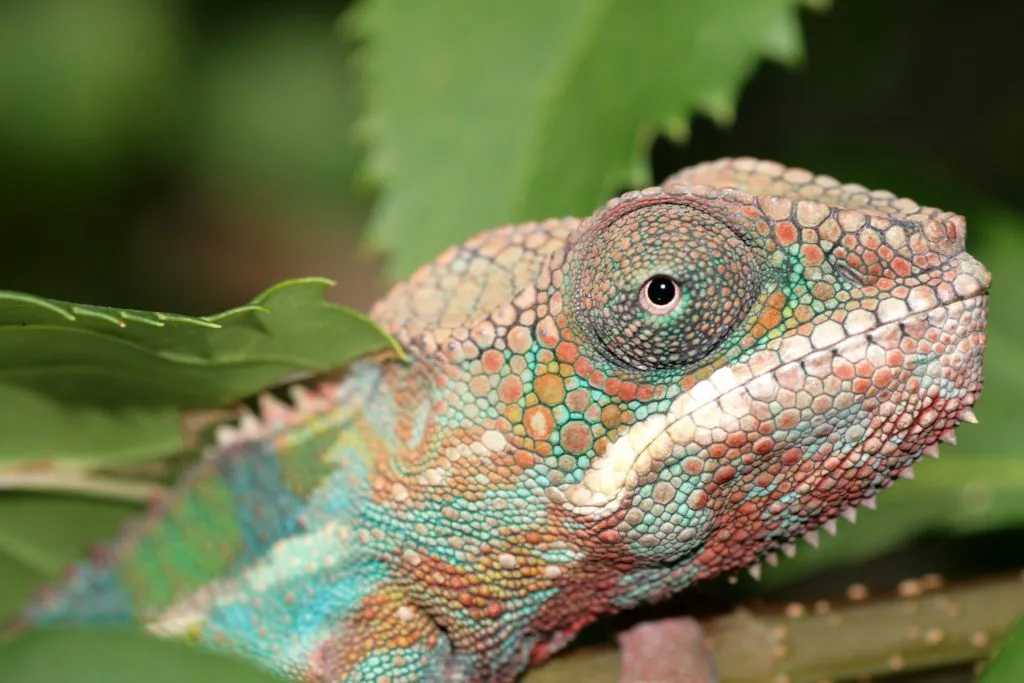
What a chameleon eats and how often, depends on how old they are:
- Young chameleons – 2 to 3 times every day (insects)
- Adult chameleons – every other day (insects 2 or 3 times per week, greens 1 or 2 times per week).
Examples of insects suitable for chameleons include:
- Fruit flies
- Crickets
- House flies
- Mealworms
- Waxworms
- Silkworms
- Roaches.
Offer insects to a chameleon in a clear, raised dish that doesn’t allow insects to escape. It’s also important to dust insects with calcium powder and a vitamin supplement.
Always make sure only to offer insects of an appropriate size (no bigger than the width of their head) to your chameleon.
Examples of plant matter suitable for chameleons include:
- Dandelion flowers
- Mustard
- Turnip
- Hibiscus flowers
- Raspberries
- Mango
- Apple
- Papaya
- Squash
- Carrots.
Don’t forget, chameleons prefer to drink from leaves in their enclosure rather than from a bowl. Be sure to mist their enclosure regularly to ensure there is plenty of water available and to maintain the appropriate humidity level.
Yearly Veterinary Check-ups
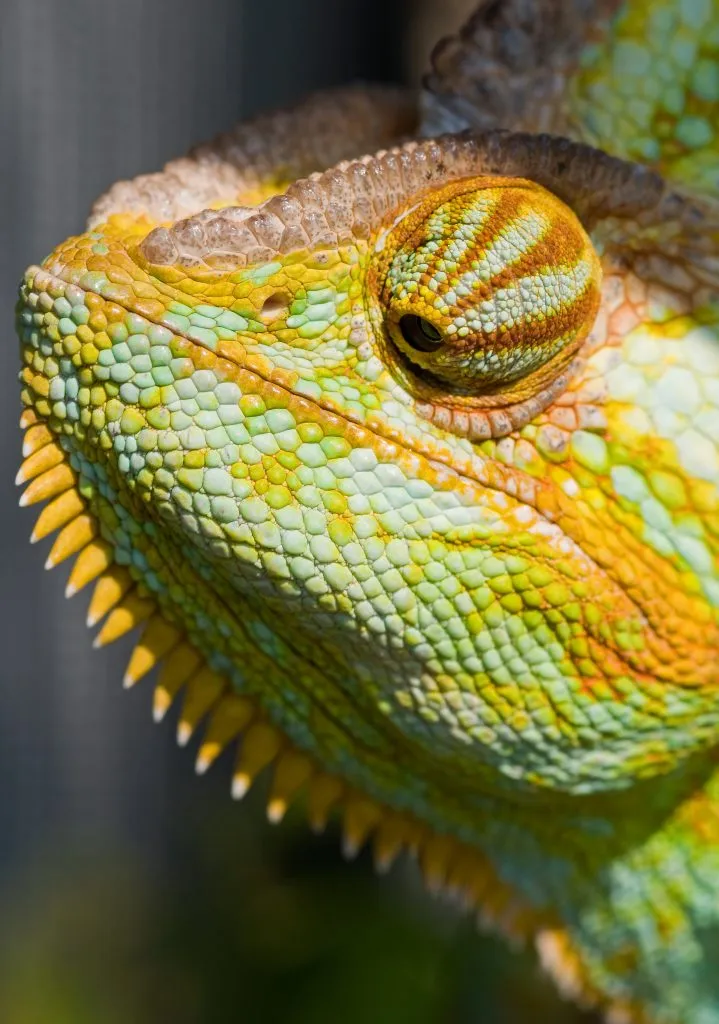
Taking your chameleon to a reptile veterinarian for a general health check every year increases the chances of detecting any health problems early on.
It also gives you an opportunity to talk to your veterinarian regarding any questions you may have.
Something else worth thinking about is having a parasitological examination for your chameleon each year. This will involve you bringing a sample of their poop to a veterinarian, who will check it for parasites or their eggs.
Frequent Monitoring
Checking your chameleon every day will help you to learn what is ‘normal’ for them and means that if something is wrong, it will be noticed quickly.
We’ve listed some things to think about when checking on your chameleon below:
- Do they appear, bright, alert, and active?
- Do the poop and urates appear normal?
- Have they eaten all their
food ? - Are the environmental parameters (humidity, temperature, light) appropriate?
Another good practice is to weigh your chameleon regularly (once per month). You can do this easily by placing the chameleon in a plastic box and using kitchen scales.
Conclusion
As we’ve shown in this article, the best way to help your chameleon stay healthy is by keeping them in a
These things will help you to spot any potential problems early, and increase the chances of proper diagnosis and successful treatment.
You can read more about poor health in chameleons in our article: 7 Signs That Your Chameleon Is Dying.
- Enchi Ball Python: A Unique and Stunning Morph of Python regius - March 27, 2025
- Emerald Tree Monitor: The Enigmatic Green Guardian of the Rainforest - March 26, 2025
- The Egyptian Cobra (Naja haje): A Fascinating Serpent - March 25, 2025
